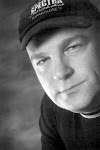This first image was taken with a single strobe and a reflector. The strobe was on the Brides left (your right) and was aimed into a 32" umbrella. A white reflector was to the brides right (your left) to fill in the shadow. The background was lite with ambient light and balanced to the strobe light by dragging the shutter. Lightroom was used to desaturate the photograph and to put a vignette around the image.
 Of course its alway fun to see what you can do with the light that exists. I am always on the lookout for interest light pockets. One part of the church was an art gallery with spot lights intended to light the artwork. To create this image I positioned the bride so that the lights would shine on the dress and bring out the detail in its design. I then had the bride look up to the light to create a pleasing light pattern on her face. Lightroom was used to desaturate the image and put a vignette around the edge.
Of course its alway fun to see what you can do with the light that exists. I am always on the lookout for interest light pockets. One part of the church was an art gallery with spot lights intended to light the artwork. To create this image I positioned the bride so that the lights would shine on the dress and bring out the detail in its design. I then had the bride look up to the light to create a pleasing light pattern on her face. Lightroom was used to desaturate the image and put a vignette around the edge.










